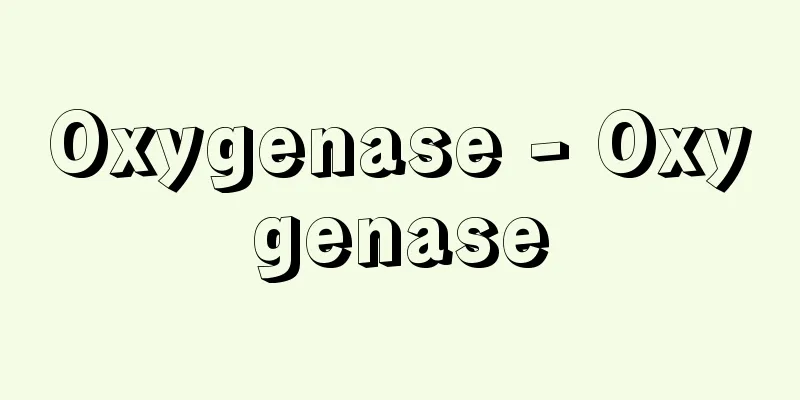Oxygenase - Oxygenase

|
A type of oxidoreductase (a general term for enzymes that catalyze oxidation-reduction reactions), a general term for enzymes that catalyze the reaction in which oxygen atoms (O) from molecular oxygen (O 2 ) are directly incorporated into organic substrates. Also called oxygenase. A group of enzymes that belong to "EC1. Oxidoreductases" according to the classification of enzymes established by the Enzyme Commission of the International Union of Biochemistry (now the International Union of Biochemistry and Molecular Biology) (see the Enzyme Number section). Oxidoreductases are enzymes that catalyze oxidation-reduction reactions in living organisms, and are called oxidases, oxygenases, dehydrogenases, reductases, etc. depending on the type of reaction. An oxidation-reduction reaction can be said to be a reaction in which electrons are transferred from one substance to another. The substance that has lost electrons is said to be oxidized, and the substance that has received electrons is said to be reduced. In general, when a substance Among oxidoreductases, enzymes that oxidize substrates (substances that undergo enzymatic reactions) using oxygen as an electron acceptor are collectively called oxidases. Oxygen is mainly converted into water or hydrogen peroxide, or is incorporated into organic compounds. Enzymes that catalyze the latter are often distinguished as oxygenases. In other words, oxygenase is a general term for enzymes that catalyze the reaction in which the oxygen atom (O) of molecular oxygen (O 2 ) is directly incorporated into organic substrates. Oxygenases are widely distributed in humans, animals, plants, and microorganisms, and play important roles in the metabolism of amino acids, lipids, hormones, and drugs and toxins. They are classified into the following two groups: (1) A group of enzymes (monooxygenases) that catalyze the reaction of adding one oxygen atom to molecular oxygen ( O2 ): S + O2 + AH2 → SO + A + H2O [Tokuhisa Sachiko] "Lloyd L. Ingraham et al., translated by Mitsuyoshi Matsuo, "Biochemistry of Oxygen: Mechanism of Diatomic Oxygen Reactions" (1991, Academic Press Center) [Reference] | | | | | | | | | | | | | | | | |Source: Shogakukan Encyclopedia Nipponica About Encyclopedia Nipponica Information | Legend |
|
酸化還元酵素(酸化還元反応を触媒する酵素の総称)の一種で、分子状酸素(O2)の酸素原子(O)が直接有機基質に取り込まれる反応を触媒する酵素の総称。酸素添加酵素ともいう。国際生化学連合(現在は国際生化学・分子生物学連合)の酵素委員会が制定した酵素の分類による「EC1.酸化還元酵素」に属す酵素群(酵素番号の項目参照)。酸化還元酵素は生体内における酸化還元反応を触媒する酵素であり、反応の様式により、酸化酵素(オキシダーゼ)、酸素添加酵素(オキシゲナーゼ)、脱水素酵素(デヒドロゲナーゼ)、還元酵素(レダクターゼ)などとよばれる。 酸化還元反応とはある物質から他の物質へ電子が渡される反応であるといってもよい。電子を奪われた物質は酸化された、電子を受け取った物質は還元されたという。一般に、ある物質が 酸化還元酵素のうち、酸素を電子受容体として基質(酵素反応を受ける物質)を酸化する酵素を酸化酵素と総称する。酸素は主として水や過酸化水素となったり、有機化合物中に取り込まれたりする。後者を触媒する酵素はオキシゲナーゼとして区別することが多い。すなわち、オキシゲナーゼは分子状酸素(O2)の酸素原子(O)が直接有機基質に取り込まれる反応を触媒する酵素の総称である。 オキシゲナーゼは人間をはじめ、動物、植物、微生物に広く分布し、アミノ酸や脂質、ホルモンや薬物毒物の代謝に重要な役割を果たしている。次の2群に分類される。 (1)分子状酸素(O2)の酸素1原子を添加する反応を触媒する酵素群(モノオキシゲナーゼ)。S+O2+AH2→SO+A+H2O [徳久幸子] 『Lloyd L. Ingraham他著、松尾光芳訳『酸素の生化学――二原子酸素反応の機構』(1991・学会出版センター)』 [参照項目] | | | | | | | | | | | | | | | | |出典 小学館 日本大百科全書(ニッポニカ)日本大百科全書(ニッポニカ)について 情報 | 凡例 |
>>: Oxychloride cement - Oxychloride cement
Recommend
Gothenburg
A port city on the Kattegat Strait in southwestern...
distance measurement
...The location of 1st, 2nd and 3rd order triangu...
AIA - Automated Identification
Aerospace Industries Association : The American ae...
Chromel
…It is an alloy whose main component is nickel (N...
A package of silver
…In the Edo period, one silver coin meant 43 momm...
Sensui Island
A small island in Tomonoura, Fukuyama City, south...
relative surplus-population
…A population that is too large compared to the a...
Wells Cathedral - Wells Cathedral
St. Andrew's Cathedral is located in Wells, a ...
Pittosporum illicioides (English name) Pittosporumillicioides
… [Mikio Ono]. … *Some of the terminology that me...
Inverse Proportion
〘noun〙① A relationship between two quantities. Whe...
Quail Dance
...The dancer recites the lyrics and performs a f...
Dioryctria abietella (English spelling) Dioryctriaabietella
…[Hiroshi Inoue]. … *Some of the terminology that...
Bishop, M. (English spelling) BishopM
… By 1975, genetic engineering and DNA analysis t...
Qasim Harawī (English spelling)
…Ibn al-'Awwām's (mid-12th century) Book ...
Military
A general term for the army, navy, and air force. ...









